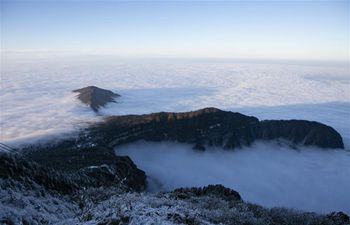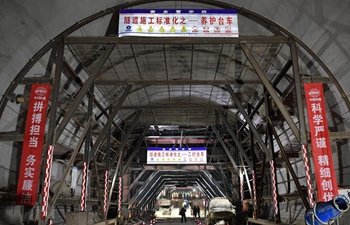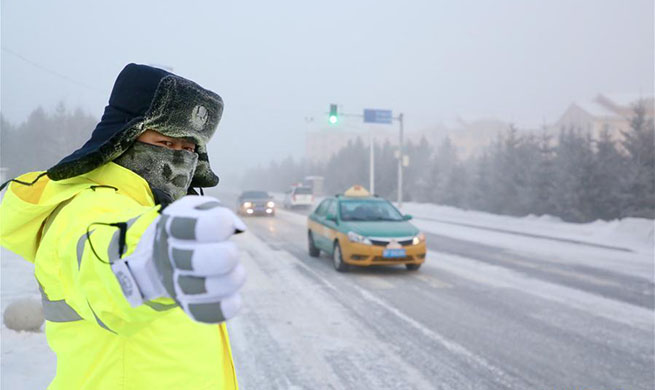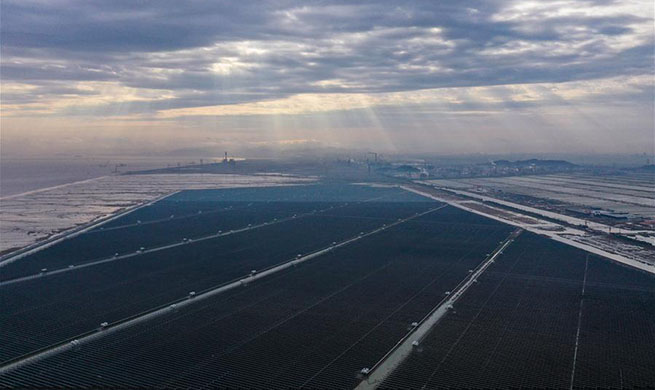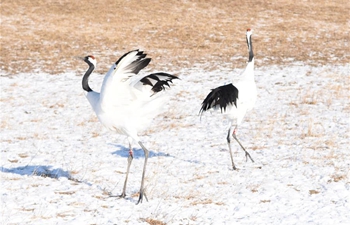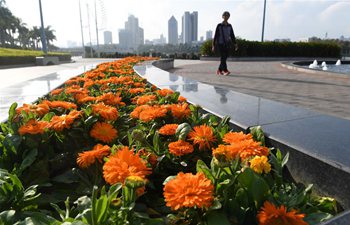by Shristi Kafle
KATHMANDU, Dec. 29 (Xinhua) -- "My father died of a cold wave at home itself two years ago in January. He was shivering for two days, and I couldn't keep him warm or save him. I don't want my children to face the similar fate," 50-year-old Nepali Ram Dev Sada said earlier this month, while he was cutting bamboos to use them as the wall for his mud-made house.
Sada's village Boriya lies few kilometers away from the town Rajbiraj, the headquarters of Nepal's Saptari district in Province 2 which is often recognized for illiteracy and poverty.
Following the damage of house in monsoon-induced flood earlier this year, one side of Sada's house was covered by his wife's colorful saree, the dress of ethnic Madhesi women in Terai region. His six-member family including two wives and three children sleep in the same wooden beds joined together and share the same blankets to prevent them from cold, which has been severe in the recent years.
"I am afraid of the cold wave, it is tough time for my family as we have only fire to keep ourselves warm. I just want winter to be over soon," Sada told Xinhua.
Sada, who works as a labor on daily wage basis, is worried about the extreme cold and the health problems it brings along with, particularly to his children. Sada said that he earns 500 rupees (less than 5 U.S. dollars) in average per day from the labor works, which can sustain daily bread and butter, but never enough to buy warm clothes and shoes or an electric heater in winter.
This is not only the state of Sada's family, but every household next door in the poor and marginalized community of Terai region carries the similar story of harsh winter, where firewood is the only savior.
Badri Narayan Mandal, a social mobilizer from the local non-government organization Save the Saptari, has closely witnessed both the increasing heat wave and cold wave and their consequences in the Dalit community. He said it's the poor people who mostly suffer as they lack appropriate winter clothes, bed and blanket and have to be dependent upon fire for heating purpose.
"When there is extreme heat or cold, people can't work outdoor. In foggy days, people usually stay inside home with dependence upon warmth of fire. Poverty is the real problem here, climate change and its impacts have added the misery," Mandal explained.
Among the seven provinces in Nepal, Province 2, where Saptari and other Terai districts are located, has the highest number of poor people. According to the government's Multidimensional Poverty Index released in 2018, more than 2.5 million people are multi-dimensionally poor in Province 2, which represents 35 percent of the total poor population.
COLD WAVES GETTING EXTREME IN LOWLANDS
Cold waves occur particularly from December to the end of January in at least 22 districts of Nepal. During the winter, these low-lying districts become colder than the mountainous region, which has minus degree temperature for at least half a year.
According to the Department of Hydrology and Meteorology, there is a formation of thick clouds leading to fog for a whole day, and as western winds pick up, both the maximum and minimum temperature declines sharply.
Their data show that the length of foggy days is increasing as compared to the past decade. Cold fog events have become more frequent and they last longer, from days to a month, with variations in their intensity and duration.
Indira Kadel, head of the climate analysis unit at the Department of Hydrology and Meteorology, said that one has to examine four factors including persistency, frequency, intensity and extent of cold to analyze the trend of cold wave. She explained that the cases of cold wave triggered by climate change have been severe particularly after the 1990s, and it was the worst in 2004, 2010 and 2017.
"There are many criteria to oversee the cold wave, which are different in different countries. In Nepal's context, we mostly see a sudden drop of at least 4- to 8-degree maximum temperature in a single day, and the continuation of such trend for over 24 hours," Kadel explained.
This year, Nepal witnessed the first cold wave on Dec. 19, with the presence of thick blanket of fog with no sign of sunshine in Terai districts, halting local people's daily lives and outdoor activities.
Meteorological Forecasting Division regularly monitors the temperature and possibilities of the cold wave, which highly depends upon western disturbances and cyclones at the Arabian Sea.
"When western wind or disturbances enter to Nepal from the Mediterranean Sea, it brings moisture along with it," Ganga Nagarkoti, a meteorologist at the division, told Xinhua.
She further said that western disturbance is developed in the Mediterranean Sea and enters to Nepal through Iran, Afghanistan and Pakistan, and cold wave usually occurs at the same time in Nepal's belt bordering Indian states.
CLIMATE CHANGE EXACERBATING HEALTH IMPACTS
Experts claim that climate change has brought many changes in human health either directly or indirectly in the mountainous and least developed country like Nepal.
Meghnath Dhimal, Chief Research Officer at the National Health Research Council, told Xinhua, "In the disaster-prone country like Nepal, there have been extreme climatic events like heavy rainfall, cold or heat wave, heavy flood and landslides and even the recent tornado, which have resulted in the increase of deaths, injury and trauma."
According to the researcher, tropical diseases have reached in the Alpine region in recent years, which is an evident consequence of climate change. Similarly, the contamination of water resources resulting to different diseases like diarrhea is another example.
"There are many other factors like food poisoning, mental problems and psycho-social impacts due to climate change, but unfortunately we have not been able to document or study about them yet," Dhimal told Xinhua.
According to data of the Nepal Health Research Council, about 262 cold waves were recorded between 2001 and 2010. In the 10-year period, about 376 people died, 80 people were injured, and 1,793 people were affected. The highest casualty was in 2004 with 108 deaths.
Dhimal said there are 42 deaths per year in Nepal in average due to the cold wave alone. However, since reporting is done under the Home Ministry instead of the Health Ministry, many cases go unreported. Since local people don't bother to opt post-mortem, many deaths triggered by the cold wave are not recorded.
Children, pregnant women and elderly people are at most risk from the extreme cold who mostly suffer from the illness like cough, fever, pneumonia, respiratory diseases and cold diarrhea among others.
"Children are mostly admitted for pneumonia, cold diarrhea and skin diseases, while the elderly citizens mostly suffer from hypothermia and respiratory problems. There is a risk of death in both," Chuman Lal Das, chief medical superintendent at Gajendra Narayan Singh Hospital based in Rajbiraj, told Xinhua.
Besides the direct impacts in human health, the events like heat wave and cold wave also diminish the working capacity or productivity of people, particularly labors and others who work in industries. Many farmers are of view that they have been affected in terms of low agricultural production leading to food insecurity and malnutrition among children.
POOR PREPAREDNESS
Shambhu Prasad Regmi, under secretary at National Emergency Operation Center under the Home Ministry, said that at least 11 Terai districts are being provided with one million rupees, while the remaining 11 will receive 500,000 rupees to address the cold wave this year.
According to the officer, the relief materials will be provided to the most vulnerable and needy people, which includes distribution of blankets, firewood and warm clothes.
"Obviously, we have kept this issue as the top priority. Every year before winter begins, we prepare an action plan after consultation with different agencies and mobilize resources accordingly," Regmi said, adding that they are gradually mobilizing newly formed local governments for the implementation.
While the government authorities claim that they have considered the disaster with utmost urgency, local people expressed dissatisfaction stating that they usually feel the government's visible presence and keenness only after the disaster hits hard as a minimal relief package distributor.
The Department of Hydrology and Meteorology admitted that there has not been much attention given to the research about the increasing impacts of climate change.
"We lack research institutes compared to other countries. Unfortunately, we don't even have a research unit, and there is not enough human resource as well. So, more attention and investment is required from the government side," Kadel said.
